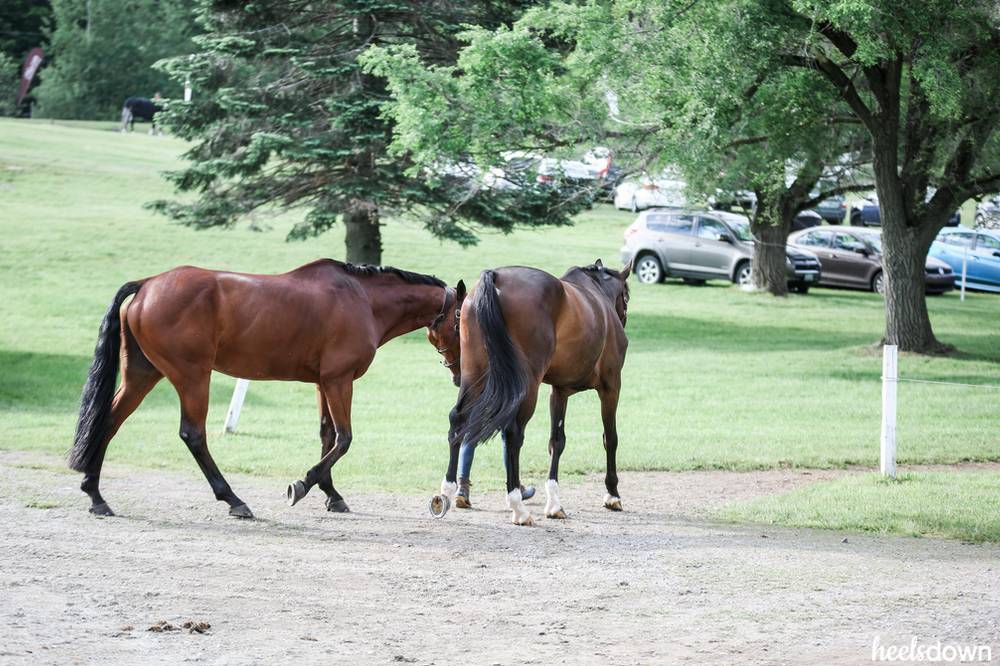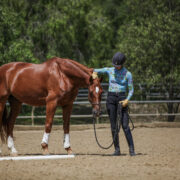Dealing With the Herd-Bound Horse

At my first horse trial with a new horse, I was both excited and nervous to run cross-country. But that excitement faded in the start box as he started rearing and fussing, like the numbers counted down were a threat. He pulled and bulged to the first jump, and I was unceremoniously dumped in front of jump two. I watched him run back toward the barns with gusto.
His herd-bound behavior had reared its ugly head. And I had eaten some dirt in the process.
Herd-bound behavior doesn’t have to spell the end of your riding partnership (it certainly hasn’t for me). There are steps you can take to lessen its hold – and to keep it from initially developing.
Typical herd-bound behavior is a horse bulging and pulling to get back to his group of friends. Or, it can be two or more particular horses that are inseparable, calling to each other across the barn aisle or whinnying like crazy in the pasture.
No matter how it presents, herd-bound and barn sour behavior can be the result of a horse’s need for security and being engaged, says Canadian four-star eventer Kyle Carter based in Ocala, Fla. “They’re herd animals. You can’t hate them for it, but you can watch how you’re dealing with them.”
The last thing you want to do is show them how boring you are.
He has seen his share of herd-bound horses over the years. “It’s long-term, but to me it’s very simple fixing,” said Kyle, 49. “We address it with the idea that the rider’s input should be more important than the horse’s natural desire. You have to fill the void that they need to make the result you’re looking for.”
While Kyle says some horses are just born prone to this behavior, it is correctable and preventable. Especially for young horses that are attached to their fellow youngsters, changing up their world is key. Move their stalls and pasture space often.
Like This Story? Try: Am I Over-Supplementing My Horse?
“Create the sense that their boundaries aren’t just this little space around them and they have to adapt wherever they are,” Kyle explained.
Change It Up
Other times, the behavior shows up under saddle when the rider isn’t providing the interest or leadership the horse needs. “They’ll just be standing at the mounting block [refusing to move], saying to the rider, ‘You’re an idiot. I don’t have to listen to you,’” he described.
Riding horses alone and outside of the ring can be a solution. Prevent boredom and the horse’s thought that his friends are most interesting than you – and change it up a lot.
Sometimes, the rider can create this kind of problem, though.
“People are training horses, and they’re not aware they’re training. It tends to be identified once it becomes a problem,” Kyle said.
For example, people often canter back and pull up right in front of the others in a group. Or, a rider canters to the edge of the arena and immediately exits – or worse, canters out of the arena.
“Now the horse gets the idea that that’s where it should go, and that’s where it wants to be anyways,” Kyle explained. “You degrade the human-horse relationship with that kind of thoughtless training. The horse learns the habit.”
Instead, Kyle said to pull up away from the group and quietly walk back. While you’re riding, make him think so he has to focus on you instead of his friends. Have a plan, and be interesting to the horse.
“I wouldn’t be excited about your input if your input is so boring that the horse has got drool coming out of its mouth,” Kyle admitted. “So of course the horse wants to go back to its friends. Be more engaging than the herd.”
Large And In Charge
Part of being engaging is to be in charge, and that leadership will lessen his will and ability to run back to his friends. “The vacuous presence of the human rider creates horses thinking there’s no rider that they’re going to bounce against,” he said.
But that doesn’t mean you need to be a stern rider all the time. Set the tone, and then don’t carry a grudge. Once the horse has his game face on, reward. “You have to ride them with love at that point. But at the same time, you have to be aware that there’s sometimes a quick switch,” Kyle said.
We address it with the idea that the rider’s input should be more important than the horse’s natural desire. You have to fill the void that they need to make the result you’re looking for.
At horse shows, be aware that herd-bound behavior can be exacerbated, as the horse might not feel as secure in an unfamiliar place. Instead of hand walking, ride the horse around the grounds. “I will take them everywhere. Any place I can ride on safely, I’m going there. Nothing defeats the little world being 20 or 40 meters like expanding their horizons,” Kyle said.
Above all, know your horse. Does time off worsen the behavior? Work him more. Does overworking cause boredom, thereby pressing that herd-bound button with fervor? Do 15 good minutes and then go for a walk.
“The last thing you want to do is show them how boring you are.” (Don’t worry, Kyle. We’ll never think you’re boring!)


